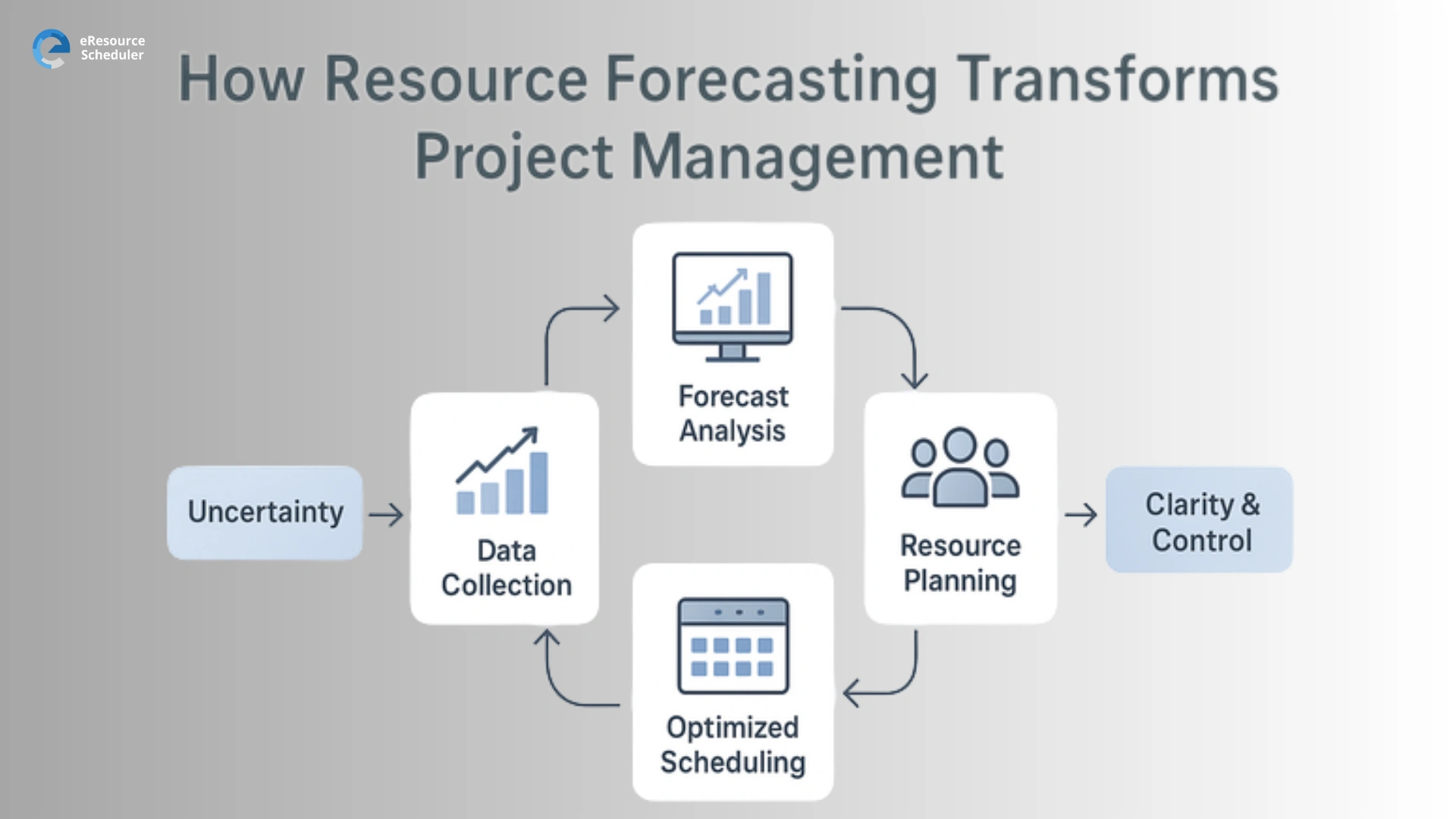
Project management has evolved dramatically over the past few years. The rise of hybrid teams, fluctuating client expectations, and tighter delivery cycles have made one thing clear, traditional reactive planning no longer works.
Modern project managers are moving toward predictive management, where they don’t just respond to change; they anticipate it. Resource capacity planning software plays a crucial role in this shift, helping leaders forecast workloads, identify potential gaps, and make smarter staffing decisions before issues arise.
In 2026, this approach became standard practice among successful U.S. project teams. Those who plan ahead are better equipped to handle sudden demand spikes, skill shortages, and shifting priorities, without losing control of timelines or team morale.
At its core, resource forecasting predicts what resources, people, time, and skills, will be needed to complete future projects. It draws from historical data, current project pipelines, and market trends to estimate future workloads.
By forecasting early, project managers ensure they always have the right mix of talent available when new projects begin. This foresight enables organizations to stay agile, reduce staffing friction, and improve delivery consistency.
Resource forecasting depends on three interconnected elements:
Balancing these factors prevents resource shortages or inefficiencies. Through effective resource capacity planning, organizations can align their workforce supply with project demand, ensuring productivity without burnout.
True forecasting looks beyond people. It includes budgets, equipment, and even software requirements. For instance, knowing that your design team’s workload will double next quarter might mean forecasting additional licenses or cloud storage needs.
In 2026, leading teams treat forecasting as a company-wide discipline, combining people, tools, and finances into one cohesive operational plan.
Forecasting isn’t just about predicting numbers, it’s about preparing people, timelines, and budgets for what’s next. When used strategically, it turns project management from reactive coordination into proactive control.

When project managers understand future demand, they can allocate resources strategically rather than reactively. Forecasting makes resource scheduling more intelligent by matching people’s availability and skill sets with upcoming project needs. It minimizes idle time and ensures no one is overbooked.
By analyzing future workloads, forecasting helps spot potential risks before they escalate. Managers can identify overworked departments or critical skill gaps early and adjust plans accordingly. This proactive approach reduces delays, cost overruns, and project stress.
Accurate forecasting enhances delivery predictability. Clients appreciate when projects stay on schedule and communication is transparent. Knowing your team’s future capacity allows for realistic timelines that protect both client trust and internal morale.
Forecasting transforms capacity planning from a reactive report into a strategic advantage. By linking forecasts to long-term business goals, project managers can plan hiring, upskilling, or vendor partnerships months in advance. The result is a workforce that evolves with the organization rather than lagging behind it.
The real power of forecasting lies in how teams use it day to day. From predicting workload peaks to aligning capacity with upcoming projects, here’s how leading organizations turn insight into action.
High-performing U.S. teams use resource forecasting as a continuous loop of insight and adjustment. They combine time tracking, project pipeline data, and utilization reports to predict staffing needs with remarkable accuracy.
For example, a marketing agency might forecast an influx of client campaigns in Q2 and preemptively shift available designers and copywriters before workloads peak. This forward-thinking approach keeps operations smooth even during busy seasons.
A reliable model depends on consistency and data accuracy. Forecasting works best when supported by structured processes for capturing timesheets, task completion rates, and utilization metrics.
Teams also scale faster when they integrate forecasting into their regular planning cycles. Weekly reviews of capacity and workload data ensure decisions reflect current realities, not outdated assumptions.
This measures how effectively resources are being used. A balanced utilization rate indicates healthy productivity, while extremes often signal poor planning.
Tracking this ratio helps organizations understand profitability and workload efficiency. Forecasting based on billable hours keeps revenue projections accurate.
Analyzing upcoming project opportunities helps teams forecast future hiring needs or potential bottlenecks well in advance. The stronger your visibility into the pipeline, the more precise your forecasts become.
For organizations looking to build a structured system around these practices, a resource scheduler helps centralize visibility across all teams and projects, making forecasting far more reliable.
Forecasting today runs on intelligence, not instinct. As teams move beyond spreadsheets, AI-backed analytics and connected systems are redefining how organizations predict demand, optimize capacity, and plan ahead with precision.
Manual forecasting through spreadsheets is fading fast. Modern teams are adopting analytics-driven systems that can process real-time data and adjust automatically. Machine learning models are now capable of predicting project delays, overutilization, and capacity shortfalls before they occur.
By 2026, AI-backed forecasting tools are expected to become standard in medium and large organizations, integrating deeply with HR, finance, and project management platforms.
The best systems are those that connect data from every part of the business. Look for platforms that provide visibility into skills, utilization, and financial metrics in one dashboard. Real-time reporting and intuitive visualization are key to faster decision-making.
Accuracy improves when forecasting tools sync with time tracking, CRM, and financial systems. These integrations ensure every staffing and budgeting decision reflects real data instead of assumptions.
One of the biggest forecasting pitfalls is assuming that every team member can contribute full-time. Managers often forget to factor in meetings, training, and administrative work, which reduces actual availability.
Historical performance holds valuable insight into future trends. Disregarding it can lead to repeated planning errors. Incorporating past project outcomes helps refine future predictions.
Projects rely on more than just people. Ignoring the availability of tools, software, or physical assets can create unexpected delays. Forecasting must include every resource that affects project timelines.
Forecasts lose accuracy quickly in dynamic environments. Regularly revisiting and updating them keeps plans aligned with real-world changes. This is where effective resource capacity planning provides stability and accuracy over time.
Accurate forecasting turns planning into profit. It strengthens utilization, stabilizes margins, and gives leaders the confidence to make smarter, data-backed decisions.
Balanced workloads keep employees engaged and productive, reducing attrition and improving morale.
Accurate forecasts align project revenue with resource costs, creating consistency in profit margins and financial planning.
Reliable forecasting data gives leaders confidence to pursue new business opportunities, knowing exactly when and where resources will be available.
The future of resource forecasting lies in predictive intelligence. As machine learning and AI continue to evolve, forecasting is shifting from a static process to a dynamic, self-correcting system. Predictive analytics now enables teams to identify demand fluctuations and potential resourcing conflicts weeks in advance, while AI-assisted planning tools automatically adjust schedules and allocations in real time.
By 2026, forecasting will no longer be just a project management function, it will be a strategic superpower. Organizations that harness it effectively will gain a clear edge in efficiency, agility, and talent retention.
Resource forecasting isn’t crystal-ball stuff, it’s clarity, backed by data. It helps teams spot what’s coming, plan smarter, and stay calm when projects get chaotic. Because let’s be honest, the future rarely sticks to the plan.
As 2026 unfolds, the teams that forecast don’t just react, they lead. Want to see what that looks like in action? Book a quick demo of eResource Scheduler and see how planning ahead actually feels effortless.
1. What is resource forecasting in project management?
Resource forecasting is the process of predicting future resource needs, people, time, skills, and budget, to ensure projects run smoothly without delays or resource shortages. It allows project managers to plan ahead and allocate efficiently.
2. How does resource forecasting improve resource scheduling?
Forecasting provides visibility into upcoming workloads, helping project managers assign the right people to the right projects at the right time. It transforms resource scheduling from guesswork into a data-driven, balanced approach.
3. What’s the difference between resource forecasting and resource capacity planning?
Resource forecasting predicts future demand, while resource capacity planning determines whether your current team has the bandwidth to meet that demand. Together, they help managers optimize workloads and avoid overbooking.
4. Why is resource forecasting important for hybrid teams?
Hybrid teams often face visibility challenges across time zones and projects. Forecasting tools help managers anticipate workload distribution, maintain balance, and ensure that remote and in-office employees remain equally utilized.
5. What are the key metrics to track in resource forecasting?
The most valuable metrics include utilization rate, billable versus non-billable hours, and project pipeline trends. Tracking these ensures more accurate forecasts and stronger project outcomes.
Plan Smarter. Schedule Faster.
Join thousands already using eResource Scheduler to align teams, time, and tasks seamlessly.